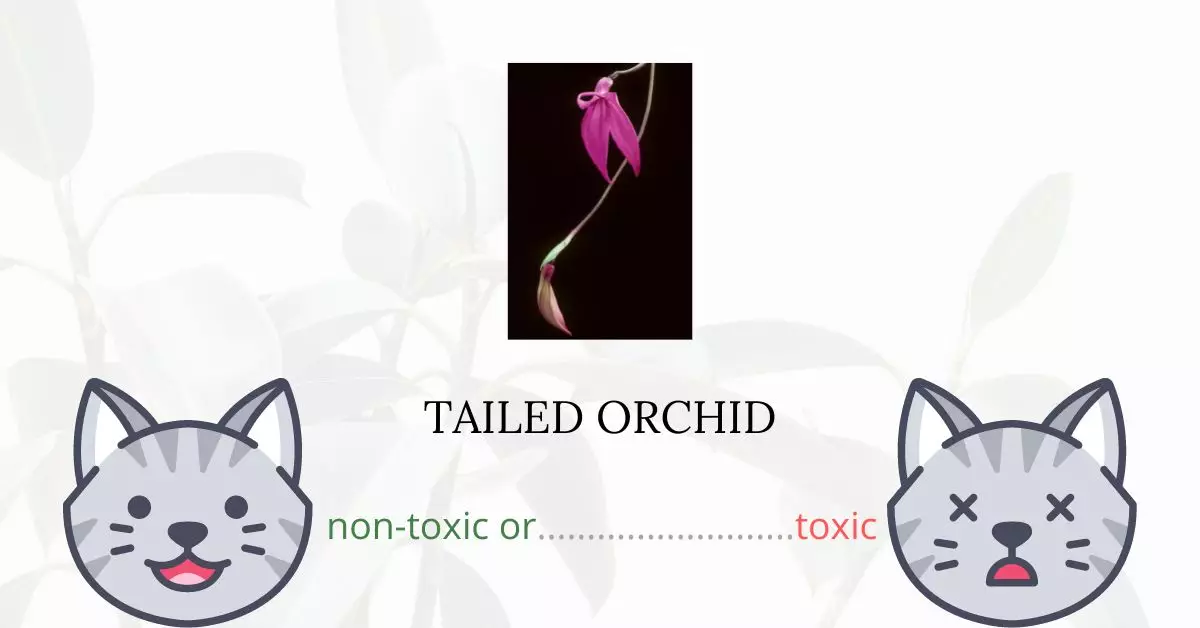Tailed Orchids are not toxic for cats. Like other orchid species, the tailed orchid is deemed safe for our feline friends.
This article was written in collaboration with a team of experienced DVMs (doctors of veterinary medicine). Their expertise, combined with our research from high-authority websites such as the ASPCA and PetMD, ensures that our readers receive accurate and up-to-date information about the potential risks associated with various plants, particularly the Tailed Orchids, and their effects on cats.
The Poison Control Center of ASPCA (American Society for the Prevention of Cruelty to Animals) has specifically categorized the tailed orchid as a non-toxic plant for cats, dogs, and horses. However, despite its non-toxic nature, it remains essential to observe your cats’ behavior around plants to ensure their safety.
Can Cats Eat Tailed Orchid?

In case your cat has accidentally bitten or eaten a tiny amount of tailed orchid, he will not experience any adverse effects. But, you should remember that consuming excessive amounts of tailed orchid, or any kind of plant, can cause gastrointestinal issues and indigestion in cats.
Since cats are known to be obligate carnivores, their main source of nutrition is protein-based meals. This indicates that plants are not suitable to be included in their regular diet.
Additionally, some fertilizers and pesticides may leave residues on your plants. If your cat ingests these toxic residues, he/she may experience poisoning and it can be fatal.
What is Tailed Orchid?

Tailed orchids, also known as masdevallia species, are a large genus of flowering plants in the Pleurothallidinae subtribe of the orchid family (Orchidaceae). There are over 500 masdevallia species, which are divided into several subgenera.
Tailed orchids can be found from Mexico to southern Brazil, but they are mostly found in higher elevations. These plants are distinguished by a short to long, creeping rhizome that gives rise to stems devoid of pseudobulbs. A single fleshy, erect to pendent, ovate to lanceolate leaf grows on their stems. The triangular flowers appear singly or in racemose inflorescences.
These orchids are vulnerable to poor environmental conditions. When subjected to unsuitable conditions, they may exhibit stress symptoms such as leaf spotting or dropping. They are usually grown in pots with sphagnum moss or seedling-grade wood chips. Only a few species, however, have descending inflorescences and are therefore best suited to baskets.
Keeping Cats Away From Tailed Orchid

Cat-repelling products are widely available on the market. Citronella, for instance, is reliable and wonderful to use because it scares off not only cats but also other animals. You could also create your own cat deterrent at home. Applying vinegar, raw onion, and citrus peels are examples of home remedies.
Try giving your cat his own space, preferably on the other side of the yard. This method will distract them away from your prized plants and deter them from entering the flowerbed. Catnip or valerian plants will attract cats. You may create an outdoor litter box filled with dry sand for them to dig in and stay out of your garden.
Plants to Avoid For Your Cats
If you are a cat owner and unsure if the plants growing in your yard are harmful to your cats, check out this list of toxic plants for cats. You can also check our list of non-toxic plants for cats.





